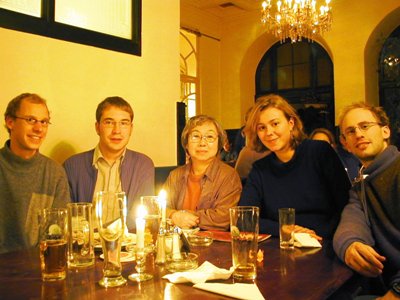2011年10月04日
41 America 4-06
In October, 1962, at the time of the Cuba Crisis, I was nine years old then, living in The people who deplore the nuclear power
There are many people who are involved in anti-war activities including the abolition and reduction of nuclear weapons and disarmament in the U.S. Because they live in a country which has nuclear weapons, their concern is greater than ours.
On April, 22, 2005, I visited Ms. Carah Ong in the office of the Nuclear Age Peace Foundation based in California. The foundation had just moved its base to Washington, D.C. We were the first visitors.
Ms. Ong said, “Unfortunately, the Bush administration seems not to be interested in the NPT Review Conference. Unloaded warheads are stored in Texas. The annual budget for nuclear arms is 40-billion dollars, which is used for the research of nuclear arms or the longer sustainability of warheads and so on. In a word, they use the money for the improvement of nuclear arms. We have to educate people in the U. S. so that they will be aware that nuclear arms eventually threaten their lives. We need to make them focus on the issue, otherwise nuclear disarmament won’t be realized. Many people are worried that if we renounce nuclear weapons, our country will be weakened. So we are trying to persuade them that our military is stronger than all other nations, our defense level would not be affected without nuclear arms. It is of no use to intimidate invisible terrorists with nuclear weapons.” Ms. Ong, in her 20s, talked with enthusiasm.
The next day, we visited Mr. John Pike, the founder of Global Security Org. They uploaded a U.S. classified document, NPR (Nuclear Posture Review), on their website in March, 2002. The document include the US determination to use nuclear arms on countries against the United States. Mr. Okada, a journalist from the Chugoku Shimbun Newspaper, asked him, “How did you get the document?” Mr. Pike answered jokingly. “From a fax machine.” Then he started a talk about his opinions about nuclear arms.
Kentucky. I saw the Air Force refueling fighters there, which made me realize this was war. It made me start learning about the effects of atomic bombs.
Our long war history has kept us creating new weapons. At present, the U.S. has considerably reduced nuclear weapons but failed to eliminate all of them. One of the reasons for this is that we can’t sweep out terrorists who live nowhere.
Japan has cultivated various cultures in its long history, so you have many national treasures. But the history of our country is still young. It took a long time to create atomic bombs at a great cost, so these are our national treasures” he said satirically in a plain tone.
I said to him, “There are many national treasures in Japan because of our long history. That is why we do not need nuclear arms. I hope your country will have something else, not atomic bombs.” Then I left his office.
On the way to the hotel by taxi, I saw the Arlington National Cemetery and the Iwo Jima Memorial through the window. It was cold and pouring with rain.
Donate documents on Hiroshima produced by HIS to Ms. Carah Ong
- Permalink
- by HSO
- at 15:27
- in 06-Planting Seeds for Nuclear Abolition 041-050


